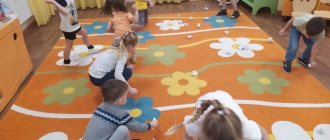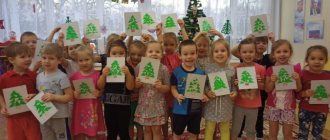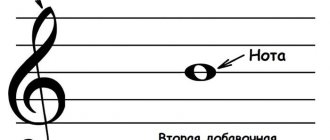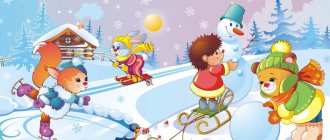Abstract of educational activities on labor education for children of the middle group
Abstract of the educational activity “Let's bake cookies” for children of the middle group
Author: Luzina Marina Aleksandrovna Position and place of work: Amur region.
city of Blagoveshchensk, teacher of MOAU pro-gymnasium Topic: “Let’s bake cookies” for children of the middle group
Description: summary of work activities for children of the middle group “Let’s bake cookies.” The main task of this lesson is to teach children to knead dough from certain products and weigh them in different ways: (scales, measuring cup, dividing butter by half). As well as the development of imagination when working with dough. Goal: introduce children to the method of making cookies Objectives: Learn to knead dough from certain products and weigh them in different ways: (scales, measuring cup, divide the product by gender) Development of imagination when working with dough
GCD move
Educator: Hello guys, I want to treat you to cookies. Do you know who makes it? Children: Yes, confectioners Educator: Do you know how they make it Children answer from their experience Educator: And today I want to teach you how to make cookies and play the role of a confectioner. Do you agree? Children: Yes Educator: then let's wash our hands, put on aprons and get to work Children put on aprons, wash their hands Educator: For a serving of cookies you need 200 grams. flour, 200 ml molak, 50 gr. sugar, 1 tsp. cinnamon and 100 gr. oils How do we measure them? Children: using scales Educator: On the table you have a tablespoon, a teaspoon, a measuring cup, scales and a table of measures of different products. How much flour do we need for cookies? Children: 200 grams Educator: How can we measure it? Children: using scales Measured and put in a bowl for dough Educator: How can we measure milk? Children: Using a measuring cup Teacher: How much cinnamon do we need for cookies? Children: 1 teaspoon Educator: Take a teaspoon and add it to the flour Children complete the task Educator: How much sugar and butter do we need? Children: 50 gr. Sahara. Educator: How can we measure these products? Children: Using scales The teacher shows how you can measure sugar using scales. Educator: Do you know that the weight of the product is also usually written on the packaging? Children: Yes Educator: Try to find it on this stick of butter Children are looking for numbers Educator: Who knows these numbers? Great, here's 200 grams. How can we take 100 grams? Children: divide in half. Educator: Correct, we need to divide by half. The teacher, together with the children, cuts off the required amount of food and kneads the dough. The dough needs to be put in the refrigerator for a while. Children at this time are practicing weighing food. Teacher: how much flour is in this bag? Who wants to weigh in? Weighing Educator: Now let's try to measure with a measuring cup. Measuring Educator: Guys, look, our dough has cooled. Now you need to roll it out, do not forget to sprinkle the table with flour so that the dough does not stick. Rolled out Educator: Now take the molds. Masha, Pasha, Katya - what shape is your mold? Educator: Now we’ll have a competition to see who can cut out the most cookies from one piece of dough, leaving as little waste as possible. Children cut out cookies. Educator: How many cookies did you get, Vasya, Zhanna, Kostya? Children: 2, 3, 2 Educator: Well, that's all, our cookies are ready, right, guys? And it can be eaten and consumed Children: No Educator: Why? Children: You still need to bake it. Educator: What can you bake cookies in? Children: In the oven Educator: Can a child set fire to the oven and cook cookies at home? Children: No Teacher: Why? Children: Dangerous Teacher: that’s right, now we’ll put our cookies on a baking sheet, greased with oil, so that the cookies don’t stick. We'll take it to our chefs and they'll bake it for us. What will the cookies be like after they are baked? Children: rosy, beautiful The teacher and the children go to the kitchen and take the cookies
Teacher: while our cookies are being prepared, let’s remember all the stages of work and depict them with symbols 1. Discuss the cookie recipe 2. Select the right products 3. Measure out the right amount 4. Mix the products 5 Kneaded the dough 6. Cooled 7. Sprinkled the table with flour 8. Rolled out the dough 9. Cut out the cookies with molds 10. Coated the baking sheet with butter 11. Placed the cookies on the baking sheet 12. Coated with egg 13. Put the oven to bake 14. Took out the finished cookies 15. Tried it While we are making up stages of preparing cookies, the cook brought them and put them on the table.
Educator: And now guys, I invite you to drink tea with our cookies
We recommend watching:
Summary of educational activities in the middle group of a speech therapist teacher using the method of hippotherapy. Notes of cognitive and research activities in the middle group. Notes of educational activities in the middle group. Wild animals in winter Summary of educational activities for familiarization with the outside world for children of the middle group
Similar articles:
Training children of the younger group in labor activities
Formation of hard work in preschool children
Folklore entertainment in the middle group
Lesson summary on the topic “Mood” in the middle group
Lesson summary for the middle group on the topic: Transport
Outline of household work (middle group)
HOUSEHOLD LABOR PLAN
Topic: “
Removing snow from the area”
Age:
middle group
Tasks for the development of labor activity:
Form the habit of labor effort, the desire to work, Teach children to hold a shovel correctly and clear the space of snow, Develop imagination, thinking, ability to carry out instructions from the teacher.
Cultivate a love of cleanliness. Objectives of moral education:
To develop the ability and desire to provide all possible assistance to a friend, to teach him what he himself can do.
Form of organization of labor activity:
Collective work.
Methods and techniques:
Showing an adult, questions, joint work of children and adults, explanation, clarification, games, approval, encouraging intermediate results, encouraging successful methods and actions of the child, reminder, artistic expression, indirect control, assessment, involving other adults in the assessment.
Preliminary work:
Observation of the activities of a janitor, a story about his work, showing illustrations, reading S. Baruzin’s poem “Interesting Machine”, Selection of equipment for children’s work, role-playing game 'Travel on a Train'.
Progress of work:
A message that now everyone will go on a train to a snowy country and play a new interesting game. The driver will be the one who is the first to dress correctly, the next 4 people will be his assistants, who will carry valuable cargo (equipment for work), and the rest will be passengers.
| Stage name | Activities of the teacher | Children's activities |
| I Organizational Goal setting Discussion of issues when distributing work | -Everyone got on the train?! Go! -Stop! Look, the traffic light is red, because... The paths and our entire site are covered with snow and the train cannot move further and we will not be able to get to our site and play there. -What needs to be done to get the train moving? -Right! — Guys, our janitor Ivan Petrovich is removing the snow. The rubbish will be cleared away from the roads and the traffic light will turn on! Let’s call him quickly, he’ll come running to us quickly, well, together, well, together: “Ivan Petrovich” - And here he is. Janitor: “What happened guys?” - Oh, guys, I'm tired, I've been sweeping the paths all day, And the snow covered them again! - Maybe we can help you? -Who wants to help Ivan Petrovich? - Well done, I knew that you would all want to help! -Look, what needs to be done? If the children find it difficult to answer, the teacher prompts (clear the paths, collect garbage, sweep the veranda) - Let's agree on how we will distribute the work: The driver and his assistants - put the snow in buckets and take it to the designated place, 1 trailer - clear the paths, 2 trailer - collect garbage, 3 trailer - sweep the veranda. So we distributed all the work among ourselves. Now get ready for it: take the necessary tools, discuss with each other the order in which you will perform your task, and start working. Don't forget that you are working together. When they work together, they help each other, don’t quarrel, and don’t get offended by their comrades’ comments.” | -Choo-chu-chu-chu-chu! -Remove the snow! (Explain) “Ivan Petrovich” I, I, I, I…. children's answers |
| II Main Instructions for managing the labor process of children | Observing the work of the children of the first group, the teacher checks how the children were able to distribute responsibilities. While observing the work of the children of the second group, if the paths are narrow, the children are warned not to crowd together; It’s better to distribute the work so that the children stand at a certain distance. The janitor shows correct execution. The work of the third group does not require close attention, but they need to be reminded of the need to collect all garbage on the territory and to wear special gloves. Children of the fourth group are asked to first sweep the veranda, and then take the snow to the designated place. Be sure to warn about careful use of a shovel, taking into account the proximity of peers. Encourages: “How wonderful and friendly the 3rd car works; Dima, you’re doing a good job,” Conducts individual work: “Sasha, look at how to hold the shovel correctly, it will be more comfortable for you and you won’t get too tired!” Pays great attention to the nature of relationships between peers. Using specific examples, he shows examples of a friendly, humane attitude towards peers, the ability to teach, show, while remaining polite and tactful. Pays attention to what has already been learned, positively evaluates these skills, as well as the desire to show working techniques and prevent the mistakes of others. | They are working |
| III Final Discussion of the results of the work | Look how our site has changed! What has changed, why? Anya very diligently swept the table. Misha, having completed his work, did not board the train, but decided to help Katyusha. A special place in his assessments is given to the specific actions of children in the labor process, which showed attention to peers, perseverance, and a responsible attitude to the assigned work. The janitor is involved in the assessment. Well done guys, they worked well, they did a great job, and now you can continue on your way: The rubbish was removed from the tracks, and the traffic light came on! Everyone in place, let's go! | Children's answers Chu-chu-chu-chu |
OUTLINE OF ORGANIZATION OF DUTY IN A SECONDARY GROUP:
Tasks for the development of labor activity:
Teach children to independently perform the duties of duty officers in the dining room: arrange bread bins, plates, place napkin holders, lay out cutlery.
Introduce the technique of folding a tablecloth. To form a responsible attitude towards a task (the ability and desire to complete a task, the desire to do it well) Objectives of moral education:
To develop the child’s desire to bring joy to other children through his work and to help a friend.
Methods and techniques:
Approval, demonstration, encouragement, reminder, control, evaluation.
Preliminary work:
Identify those on duty (pictures in the corner of those on duty) Progress of duty:
| Stage name | Activities of the teacher | Children's activities |
| I Organizational Discussion of issues when distributing work | - The officers on duty come to me, they will bring lunch now, and we will set the table. -Maxim, which table will you be on duty at? -Are you Kostya, Natasha? Before you start being on duty, don't forget to put on your aprons. | They put on aprons and caps. |
| IIBasic Instructions for managing the labor process of children | Pays attention to the pace and quality of work. Approves of children's creative ideas: - Let's think about how we will please the children today? If they find it difficult, the teacher or junior teacher suggests: “Let’s put flowers or lay out new tablecloths.” He explains that the work of the attendants is very necessary, comrades always do this, take care of each other, etc. - That's right, Natasha first pulled all the chairs towards the table. Now it will be more convenient to walk around the table. - We carry two plates. - How Kostya carefully lays out the spoons, takes one at a time and places it on the right side. -Check if everything is in place? -Well done guys, thank you. Guys, look at how to fold the tablecloth more conveniently, help me, Kostya. You need to take it by the ends, fold it in half on the table, and then in half again, and only then fold it lengthwise. Now try it yourself. Everyone did well. | Children's answers arrange bread bins, deep plates, place napkin holders, lay out cutlery. -All! -Yes! After eating, they clear the bread and napkins from the table, sweep away the crumbs from the table, and fold the tablecloths. |
| III Final Discussion of the results of the work | -Well done, guys, you were all real duty workers today, you took care of everyone! -Kostya, he remembered everything himself, didn’t forget anything. -Maxim, he worked as carefully and diligently as the nanny. - And how pleased mom will be to know that Natasha was on duty today like an adult. Here the assistant is growing. | Remove aprons and caps. |







